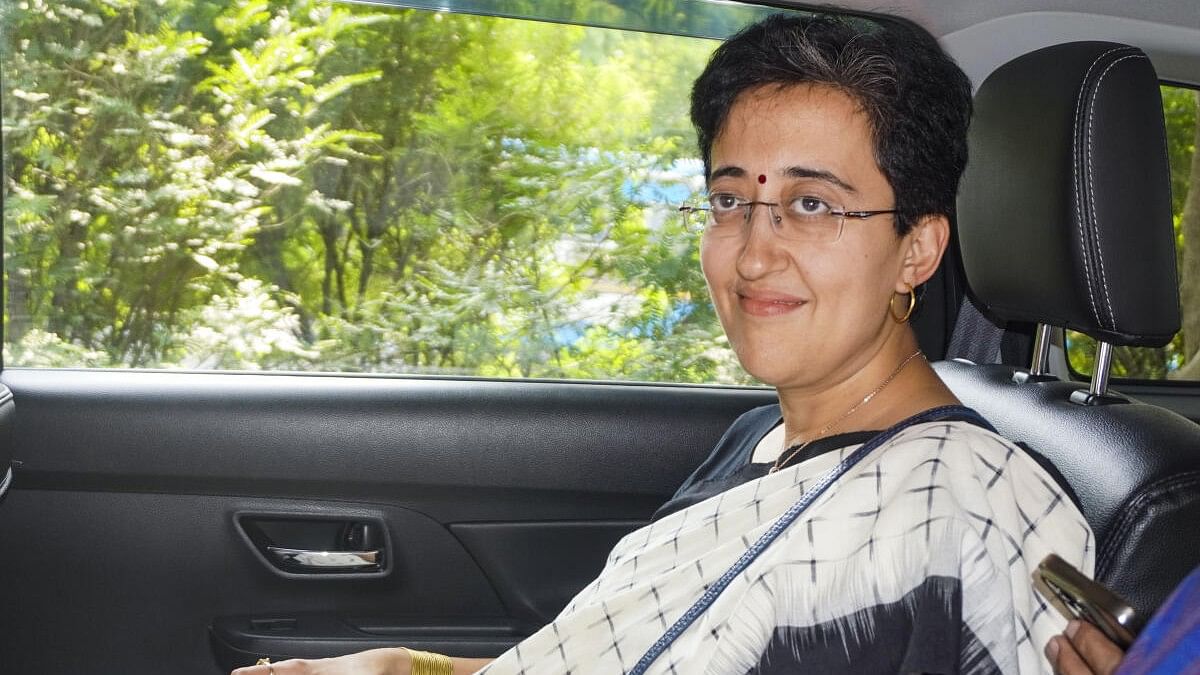
Delhi Minister and AAP leader Atishi leaves after a meeting of the legislative party at Chief Minister Arvind Kejriwal's residence, in New Delhi.
Credit: PTI Photo
As a twenty something, a young Atishi camped in rural Madhya Pradesh and involved herself in organic farming and progressive education systems, learning from the grassroots how to make a change for the underprivileged.
In her thirties, the Oxford alumna expanded from grassroot activism to politics and policy and started to experiment with what she learnt by then, especially in Delhi schools which saw welcome changes. And in her early forties she entered the government and within 18 months was chosen for a bigger assignment. By this time Atishi has already proven herself to be a 'worthy' successor of Arvind Kejriwal, a Chief Minister who attracts admiration and wrath.
As she is now all set to occupy a post only Kejriwal had occupied from AAP even though her entry into the party was not without a bit of initial hesitation.
The 43-year-old daughter of a Leftist academician couple Vijay Singh and Tripta Wahi was sceptical of the Anna Hazare-led India Against Corruption movement, which Kejriwal designed ahead of his political entry, as she felt it was a single agenda movement that may not go long.
However, her constant interaction with AAP leaders, including Prashant Bhushan, led her to the party.
As Kejriwal grew political ambitions and worked on a policy alternative, she joined a bunch of activists, academicians and policy wizards to design the agenda for the young party.
She was part of the manifesto drafting team when the AAP first fought the Delhi Assembly elections in 2013.
She remained behind the scenes but in 2015 when AAP returned to power, the then Deputy Chief Minister Manish Sisodia drafted her into his team as an advisor to helm the reforms in the sector.
She helped Sisodia navigate the treacherous policy quagmire to initiate Happiness curriculum, 'Mission Buniyad' to improve learning levels of primary and secondary students and Teacher Development Coordinator Programme and measures to rein in private schools. The famed Parents-Teachers meeting in Delhi government-run schools, hit headlines.
Her brief stint as a teacher in Rishi Valley School in rural Andhra Pradesh also helped her in finalising the plans.
But the ruling BJP at the Centre had other plans and in 2018, she saw herself dismissed as advisor as her appointment was considered to be illegal. By then, she had made her mark and AAP had announced her as a candidate for East Delhi Lok Sabha seat in 2019 polls.
The BJP had by then initiated a whisper campaign citing her surname ‘Marlena’ – a combination of Marx and Lenin chosen by her parents – that she was a foreigner and Christian. She dropped her surname saying her work would speak. She also chose not to use the caste surname Singh.
She would eventually lose the polls to cricketer-turned-BJP member Gautam Gambhir by 4.47 lakh votes but by then she had been baptised in the competitive world of politics. But she won the Assembly elections from Kalkaji next year.
All expected Kejriwal to induct her into his 2020 Cabinet but he chose to retain his team while she honed her skills as a legislator heading several crucial Assembly committees and becoming the face of the party. In March, things again changed as Sisodia resigned as Deputy Chief Minister after his arrest.
Kejriwal then inducted Atishi and Saurabh Bharadwaj into his team with a signal that she is first among the ministers by assigning her the maximum number of ministries.
When Kejriwal went to jail, Atishi’s stock was once again on the rise. She was chosen as the face of the government while his wife Sunita became a bridge between him and the party. When August 15 presented a peculiar situation with the Chief Minister in jail, Kejriwal wanted Atishi to hoist the tricolour though the Delhi LG had different plans.
As the AAP chief throws the political dice once again ahead of Assembly elections, Atishi is on the forefront, though for a limited period. Her actions will define her future legacy.
